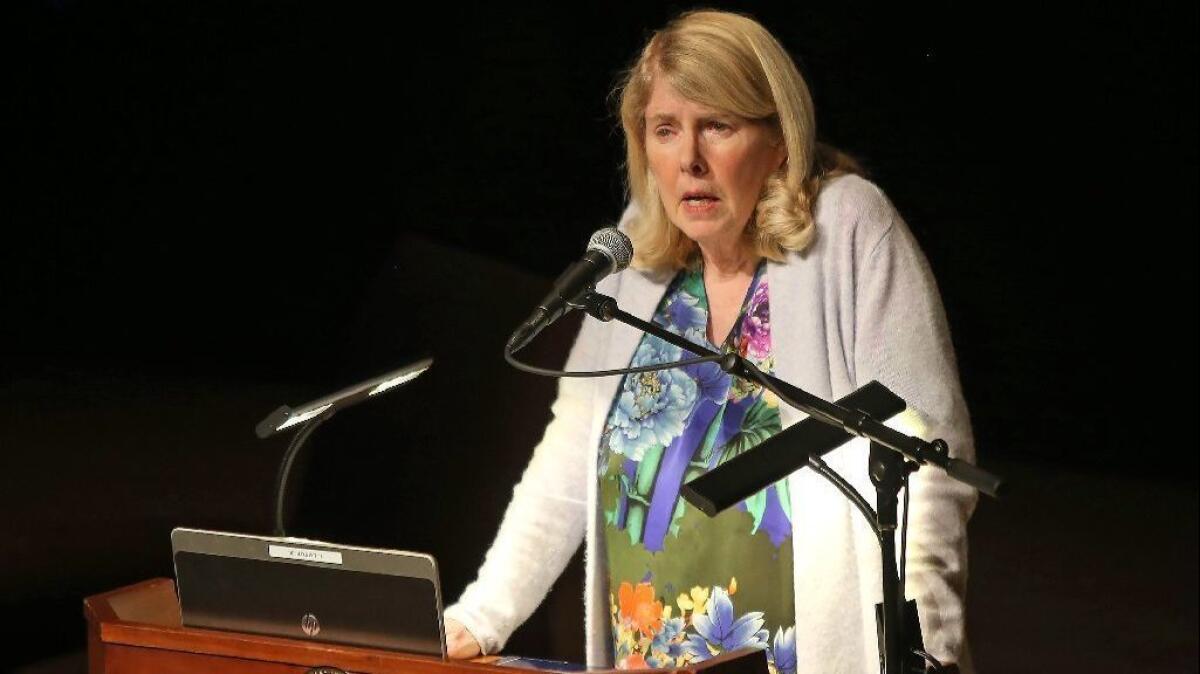National, local mental health experts offer perspective on youth suicide epidemic at Aliso Viejo forum

- Share via
Following a spate of suicides involving celebrities, mass shooting survivors and Orange County students, Soka University recently hosted “Suicide: A Conversation,” as part of the Aliso Viejo institution’s Critical Conversation series on important societal topics.
The April event addressed the prevalence of suicide, prevention and the treatment of psychiatric disorders.
“I learned as best I could and as much as I could about the moods of death,” speaker Dr. Kay Redfield Jamison read from her bestselling memoir, “An Unquiet Mind.”
Jamison is a professor of psychiatry at Johns Hopkins University and has written extensively about her research on mood disorders as well as her experience living with bipolar disorder. She has a history of suicidal thoughts and attempted to end her own life as a young adult.
“My persuasiveness to others that everything was fine was frightening,” she said.
Mortality associated with stroke, heart disease and AIDS have all significantly decreased since their respective peaks between the ’60s and ‘90s, while suicide remains as prevalent as ever, Jamison said.
Suicide, particularly among teenagers, has increased in the last 10 years, according to recently published data by the JAMA medical journal, and the once-significant gap between girls and boys is narrowing.
“We don’t look at suicide as quite the same kind of death as other illnesses,” Jamison said.
Speaker Alison Malmon founded Active Minds, a nationwide non-profit that supports student groups focusing on peer-to-peer mental health awareness and education.

She started Active Minds as a college student after losing her 22-year-old brother, Brian, a high-performing student, a cappella group leader and college newspaper sports editor.
A campus counselor recognized that Brian was struggling and suggested he leave New York City and go home to Washington, D.C. for the weekend. Once home, a clinician diagnosed Brian with schizoaffective disorder and determined that the onset of his symptoms reached back to his freshman year but had gone undiagnosed.
Brian took a leave of absence from school and sought treatment. A year and a half after his initial diagnosis, he ended his life.

Suicide is the second leading cause of death of American college students.
“This is a very high-risk age,” Jamison said.
The average onset for most psychiatric disorders dovetails with late high school and early college, a period fraught with change and stress. And suicide risk is highest around the time of onset.
A 2001 study found that for individuals with bipolar disorder, those under age 30 died by suicide at a rate 70 to 80 times greater than the general population.
Corona del Mar High School junior examines teen mental health in new book »
The death of Patrick Turner in January 2018 shook not only the Turner family, but also the Corona del Mar High School, where he was a sophomore.
“It’s an ugly club to belong to,” his mom, Kim Turner, said about being a parent who’s lost a child to suicide. “We are absolutely devastated.”
In August, the Turner family launched the Patrick’s Purpose Foundation to promote teen mental health and advocate for more diverse and inclusive ideas of adolescent success.
The foundation hosted apizza party at a local community center for Patrick’s classmates before the fall semester.
According to Turner, it was an opportunity to check in with the teenagers before the start of the school year and affirm that “they don’t need to carry the burden of Pat’s death.”
The event also emphasized that teens should check in on their peers, to “know their joys, anxieties or sorrows” and turn to a “trusted” adult when they learn that friends need support or help.
Newport-Mesa school district takes steps to improve program for preventing youth suicide »
Turner said that the high-achieving school district, which released an official response to Patrick’s death, has made efforts to reduce academic stress.
In March, the foundation hosted a panel for parents on understanding teen mental health.
Daniel Patterson, a teen and parent life coach with a practice in Newport Beach, served as a panelist. He was an assistant principal at Corona del Mar High before starting his practice, Patterson Perspective, where he uses one-on-one coaching to address the students’ needs and guide families toward appropriate tools and resources.
“I encourage parents to take their teens to a mental health provider as often as they take them to a dentist,” Patterson said, “even if everything seems to be going well.”
Regular checkups with a mental health professional can help promote healthy choices »
Another one of his goals is to reinforce the idea that therapy doesn’t have to be negative.
“Once parents take a child to a clinician, they end up understanding that it ends up not being a horrible experience,” said Patterson, “[and] if depression or anxiety sets in, you have a relationship with someone.”
He offered this scenario as an analogy: “I don’t wait for my daughter’s teeth falling out to find a dentist.”
Patterson still sees a stigma attached to addressing a child’s mood changes, whereas hopping onto Nextdoor or Facebook to find a tutor for a student struggling with AP Chem would be a no-brainer.
Jamison explained that four or five major psychiatric illnesses contribute to about 95% of suicides. These common illnesses can be lethal, but they are also well studied and often highly treatable.
“There is a real science to suicide,” Jamison said. “Although suicide is a grim topic by definition, I can do nothing but extend hope.” Patterson sees a trend for the better. Parents are paying attention.
“Right now, my sense is that teens are more open to mental health,” he said. “They are less afraid of it and more aware of it.”
All the latest on Orange County from Orange County.
Get our free TimesOC newsletter.
You may occasionally receive promotional content from the Daily Pilot.




